Table of Contents
- Why Your Print Media Needs a Powerful Online Presence
- Expanding Your Readership Beyond Print
- Diversifying Revenue Streams
- Building a Stronger Brand and Community
- Enhancing Your Editorial Content
- Planning Your Print Media Website: A Strategic Approach
- Defining Your Goals and Objectives
- Identifying Your Target Audience
- Developing a Content Strategy
- Choosing a Domain Name and Hosting Provider
- Selecting the Right Platform: CMS Options for Print Media
- WordPress: The Versatile Powerhouse
- Drupal: The Enterprise Solution
- Joomla: The Middle Ground
- Considering Headless CMS
- Designing Your Print Media Website: User Experience and Visual Appeal
- Prioritizing User Experience (UX)
- Creating a Visually Appealing Design
- Optimizing for Mobile Devices
- Accessibility Considerations
- Implementing Key Features: Functionality for Print Media Websites
- Content Management System (CMS) Integration
- Subscription Management System
- Advertising Management System
- Search Functionality
- Commenting System and Community Features
- SEO Optimization: Getting Found Online
- Keyword Research
- On-Page Optimization
- Off-Page Optimization
- Technical SEO
- Content Creation and Curation: Keeping Your Website Fresh
- Original Content Creation
- Content Curation
- Repurposing Print Content for the Web
- Engaging with Your Audience
- Analyzing and Optimizing: Measuring Your Success
- Setting Up Analytics Tracking
- Monitoring Key Performance Indicators (KPIs)
- A/B Testing
- Making Data-Driven Decisions
- Qrolic Technologies: Your Partner in Digital Transformation
- Website Development and Design
- SEO and Digital Marketing
- Content Strategy and Creation
- Consulting and Support
- Why Choose Qrolic Technologies?
- Legal Considerations: Protecting Your Content and Users
- Copyright Law
- Privacy Policy
- Terms of Service
- Advertising Standards
Why Your Print Media Needs a Powerful Online Presence
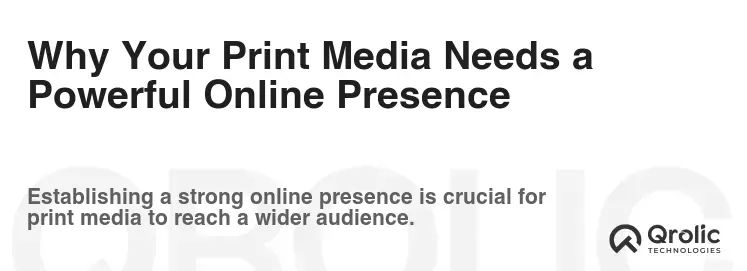
The world has gone digital, and that includes how people consume media. While the tactile experience of holding a newspaper or magazine remains valuable, ignoring the internet is like ignoring a vast, untapped audience. A print media website isn’t just a “nice-to-have” anymore; it’s a survival tool, a growth engine, and a powerful way to extend your reach.
Expanding Your Readership Beyond Print
What is the main benefit? A website immediately broadens your potential audience beyond the physical limitations of distribution. You’re no longer confined to newsstands, subscriptions, or specific geographic areas. People around the globe can discover your content.
Why is this important? Increased readership translates to increased visibility, potential advertising revenue, and a stronger brand presence.
Example: A local community newspaper, with a website, can reach former residents who have moved away but still want to stay informed about their hometown.
Diversifying Revenue Streams
How can a website generate revenue? Websites offer numerous monetization opportunities that complement print revenue.
- Digital Subscriptions: Offer online-only access to premium content.
- Advertising: Display banner ads, native advertising, and sponsored content.
- Affiliate Marketing: Earn commissions by recommending products or services.
- E-commerce: Sell merchandise, back issues, or related products.
- Events: Promote and sell tickets to events related to your publication.
When should you start exploring these? As soon as your website is established and attracting a consistent audience. Don’t wait until print revenue declines further.
Benefit: Reduced reliance on a single revenue stream creates a more stable financial future.
Building a Stronger Brand and Community
What does a website offer beyond content? A website allows you to build a deeper connection with your audience.
- Interactive Features: Forums, comment sections, and polls encourage engagement.
- Social Media Integration: Share content easily and amplify your reach.
- Email Newsletters: Keep readers informed and drive traffic back to your site.
- Personalized Content: Tailor content to individual user preferences (with user consent and GDPR compliance).
Why is community important? A loyal community is more likely to subscribe, engage with your content, and become brand advocates.
Example: A gardening magazine’s website could feature a forum where readers can share tips, ask questions, and connect with each other.
Enhancing Your Editorial Content
How can a website improve your content? The digital format allows for richer and more engaging storytelling.
- Multimedia: Incorporate videos, audio clips, and interactive graphics.
- Hyperlinking: Provide context and connect readers to related information.
- Real-time Updates: Offer breaking news and timely updates.
- Archiving: Create a searchable archive of past articles.
What problem does this solve? It addresses the limitations of the printed page and provides a more dynamic and informative experience.
Benefit: Content is more valuable, engaging, and accessible.
Planning Your Print Media Website: A Strategic Approach
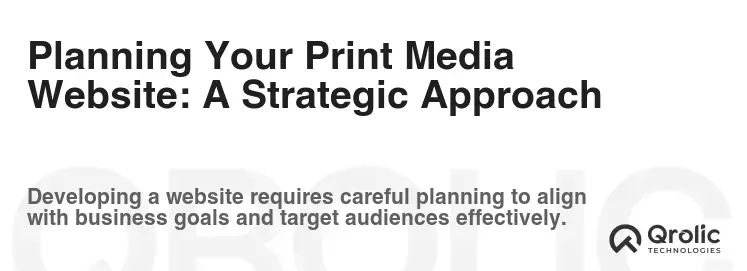
Before diving into the technical aspects, careful planning is crucial for a successful website launch. This section covers the essential steps to define your goals, target audience, and content strategy.
Defining Your Goals and Objectives
What do you want to achieve with your website? Be specific and measurable.
- Increase Readership: By what percentage?
- Generate Revenue: How much revenue do you aim to generate online?
- Build Brand Awareness: How will you measure brand awareness?
- Drive Subscriptions: How many new print or digital subscriptions do you want to acquire?
Why are goals important? They provide a clear direction and allow you to track your progress.
Example: “Increase online readership by 20% within the first year by publishing high-quality, SEO-optimized content.”
Identifying Your Target Audience
Who are you trying to reach with your website? Understand their demographics, interests, and online behavior.
- Existing Print Readers: What are their expectations for an online experience?
- New Online Readers: What are their interests and needs?
- Specific Demographic Groups: Are you targeting a particular age group, gender, or location?
How do you gather this information? Conduct surveys, analyze website analytics, and research industry trends.
Benefit: Tailoring content to your target audience increases engagement and relevance.
Developing a Content Strategy
What type of content will you publish on your website?
- Repurposed Print Content: Adapt articles from your print publication for online consumption.
- Original Online Content: Create exclusive content that doesn’t appear in print.
- Multimedia Content: Produce videos, podcasts, and interactive graphics.
- User-Generated Content: Encourage readers to contribute content through comments, forums, or guest posts.
When should you publish new content? Establish a consistent publishing schedule to keep your audience engaged.
Why is a content calendar important? It helps you plan and organize your content creation efforts.
Example: For a lifestyle magazine, the website content strategy might include repurposed articles from the print edition, original online articles on trending topics, video tutorials, and user-submitted content.
Choosing a Domain Name and Hosting Provider
Domain Name: Your online identity. Choose a name that is memorable, relevant to your brand, and easy to spell.
- Keep it short and simple.
- Use relevant keywords.
- Check for availability across different extensions (.com, .net, .org).
Hosting Provider: The company that stores your website’s files and makes them accessible to visitors.
- Consider factors like server uptime, speed, security, and customer support.
- Choose a hosting plan that meets your website’s needs and budget.
- Look for providers that offer easy-to-use control panels and one-click installations of content management systems (CMS).
Why are these important? A good domain name and reliable hosting are essential for a professional and accessible website.
Selecting the Right Platform: CMS Options for Print Media

Choosing the right Content Management System (CMS) is a critical decision. It will determine how easy it is to manage your website’s content, design, and functionality.
WordPress: The Versatile Powerhouse
What is WordPress? The most popular CMS in the world, known for its flexibility, ease of use, and extensive plugin ecosystem.
Why is it a good choice?
- User-Friendly Interface: Easy to learn and use, even for non-technical users.
- Extensive Plugin Library: Thousands of plugins available to add functionality like e-commerce, SEO optimization, and social media integration.
- Customizable Themes: Choose from thousands of free and premium themes to create a visually appealing website.
- SEO-Friendly: WordPress is inherently SEO-friendly, making it easier to rank in search engines.
- Large Community Support: A vast community of developers and users provides support and resources.
When is it ideal? For most print media organizations, WordPress offers the best balance of features, flexibility, and ease of use.
Example: A newspaper can use WordPress to publish articles, manage subscriptions, display advertising, and create an online archive.
Drupal: The Enterprise Solution
What is Drupal? A powerful and flexible CMS that is often used for complex websites with demanding requirements.
Why is it a good choice?
- Highly Customizable: Offers a high degree of control over the website’s structure and functionality.
- Scalable: Can handle large amounts of content and traffic.
- Secure: Known for its robust security features.
When is it ideal? For large print media organizations with complex content management needs and a dedicated development team.
Drawbacks: Steeper learning curve and requires more technical expertise than WordPress.
Joomla: The Middle Ground
What is Joomla? A CMS that falls somewhere between WordPress and Drupal in terms of complexity and flexibility.
Why is it a good choice?
- More Flexible than WordPress: Offers more built-in features and customization options.
- Easier to Use than Drupal: More user-friendly interface than Drupal.
When is it ideal? For print media organizations that need more flexibility than WordPress offers but don’t want the complexity of Drupal.
Drawbacks: Smaller community and fewer available extensions than WordPress.
Considering Headless CMS
What is a Headless CMS? A backend content repository that delivers content via APIs to any frontend display. The “head” (frontend) is decoupled from the “body” (backend).
Why consider it?
- Flexibility: Distribute content to websites, apps, smart devices, and more.
- Performance: Faster loading times.
- Modern Development: Allows for using the latest frontend technologies.
When is it ideal? For organizations with complex distribution needs or those wanting to create highly customized user experiences.
Example: Contentful, Strapi, and Netlify CMS are popular headless CMS options.
Designing Your Print Media Website: User Experience and Visual Appeal
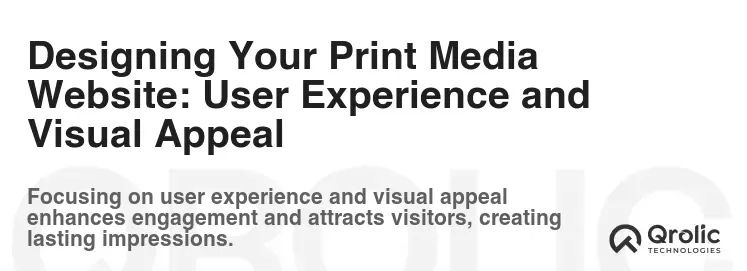
The design of your website is crucial for attracting and retaining readers. Focus on creating a user-friendly experience that is visually appealing and reflects your brand.
Prioritizing User Experience (UX)
What is UX? The overall experience a user has while interacting with your website.
Key Elements:
- Navigation: Make it easy for users to find what they’re looking for. Use clear menus, search bars, and internal linking.
- Readability: Choose a font size and style that is easy to read on different devices.
- Mobile-Friendliness: Ensure your website is responsive and looks good on all screen sizes.
- Page Load Speed: Optimize images and code to ensure fast loading times.
Why is UX important? A positive user experience encourages readers to stay longer, explore more content, and return to your website.
Creating a Visually Appealing Design
What makes a good design? A design that is both aesthetically pleasing and functional.
- Branding: Use your brand colors, logo, and imagery consistently throughout the website.
- Layout: Choose a layout that is clean, organized, and easy to navigate.
- Imagery: Use high-quality images and videos to enhance your content.
- White Space: Use white space effectively to create a sense of balance and readability.
Why is visual appeal important? A visually appealing design attracts attention, creates a positive impression, and reinforces your brand identity.
Optimizing for Mobile Devices
Why is mobile optimization important? A significant percentage of internet users access websites on their mobile devices.
Key Considerations:
- Responsive Design: Use a responsive design that automatically adjusts to different screen sizes.
- Touch-Friendly Navigation: Make it easy for users to navigate your website on touchscreens.
- Fast Loading Times: Optimize your website for mobile devices to ensure fast loading times.
- Simplified Content: Present your content in a clear and concise manner on mobile devices.
Benefit: A mobile-friendly website provides a seamless experience for mobile users, increasing engagement and conversions.
Accessibility Considerations
Why is website accessibility important? Making your website accessible to people with disabilities is not only ethical but also legally required in many jurisdictions.
Key Considerations:
- Alternative Text for Images: Provide alternative text descriptions for all images.
- Keyboard Navigation: Ensure that all elements of your website can be accessed using a keyboard.
- Color Contrast: Use sufficient color contrast between text and background.
- Clear and Concise Language: Use clear and concise language that is easy to understand.
- Semantic HTML: Use semantic HTML tags to structure your content.
Tools: Use accessibility testing tools to identify and fix accessibility issues.
Benefit: An accessible website reaches a wider audience and demonstrates your commitment to inclusivity.
Implementing Key Features: Functionality for Print Media Websites
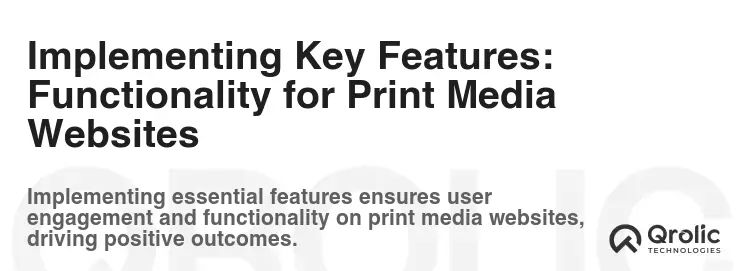
A well-designed website needs essential features to engage readers, manage content, and generate revenue.
Content Management System (CMS) Integration
What does CMS integration involve? Connecting your website’s design with the backend CMS.
- Theme Customization: Customize your chosen theme to match your brand identity.
- Plugin Installation: Install and configure plugins to add functionality like SEO optimization, social media integration, and e-commerce.
- Content Migration: Migrate existing content from your print publication or other sources to your website.
Why is it important? Seamless CMS integration allows you to easily manage and update your website’s content and functionality.
Subscription Management System
What is a subscription management system? A system that allows you to manage online subscriptions to your print or digital publications.
- Subscription Options: Offer different subscription levels with varying features and pricing.
- Payment Gateway Integration: Integrate with a payment gateway to process online payments.
- User Account Management: Allow users to create and manage their accounts.
- Automated Billing: Automate the billing process for recurring subscriptions.
Why is it important? An efficient subscription management system streamlines the subscription process and generates recurring revenue.
Advertising Management System
What is an advertising management system? A system that allows you to manage and display advertising on your website.
- Ad Placement: Define ad placement zones on your website.
- Ad Serving: Serve ads to different users based on their demographics, interests, and browsing history.
- Reporting: Track ad impressions, clicks, and revenue.
Why is it important? An advertising management system allows you to generate revenue from advertising on your website.
Search Functionality
Why is a search function important? It allows users to easily find specific articles or content on your website.
Key Considerations:
- Relevance: Ensure that the search results are relevant to the user’s query.
- Speed: Optimize the search function for speed and efficiency.
- Filtering: Allow users to filter search results by date, category, or other criteria.
Benefit: A well-designed search function improves user experience and encourages users to explore more content on your website.
Commenting System and Community Features
Why are these important? They encourage user engagement and build a community around your publication.
Key Features:
- Comment Moderation: Moderate comments to ensure that they are respectful and relevant.
- User Profiles: Allow users to create profiles and interact with each other.
- Forums: Create forums where users can discuss topics related to your publication.
- Social Media Integration: Allow users to share content on social media.
Benefit: Community features foster loyalty and encourage users to return to your website regularly.
SEO Optimization: Getting Found Online
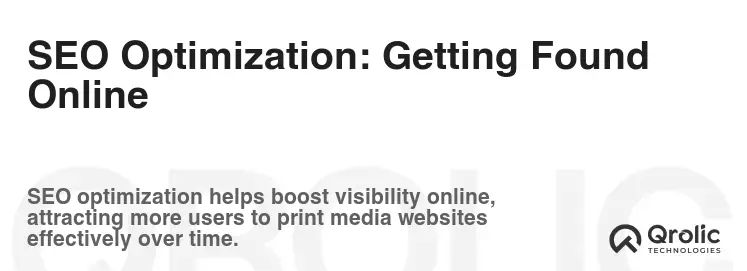
Search Engine Optimization (SEO) is crucial for driving organic traffic to your website.
Keyword Research
What is keyword research? The process of identifying the keywords that your target audience is using to search for information online.
How to do it:
- Use keyword research tools like Google Keyword Planner, SEMrush, or Ahrefs.
- Identify keywords that are relevant to your content and have a high search volume.
- Analyze your competitors’ websites to identify the keywords they are targeting.
Why is it important? Keyword research helps you understand what your target audience is searching for and optimize your content accordingly.
On-Page Optimization
What is on-page optimization? The process of optimizing individual web pages to rank higher in search engines.
Key Elements:
- Title Tags: Use relevant keywords in your title tags.
- Meta Descriptions: Write compelling meta descriptions that encourage users to click on your search results.
- Header Tags: Use header tags (H1, H2, H3, etc.) to structure your content and highlight important keywords.
- Image Alt Text: Provide alternative text descriptions for all images.
- Internal Linking: Link to other relevant pages on your website.
- URL Structure: Use clear and concise URLs that include relevant keywords.
Why is it important? On-page optimization makes it easier for search engines to understand the content of your web pages and rank them accordingly.
Off-Page Optimization
What is off-page optimization? The process of building backlinks to your website from other websites.
How to do it:
- Create high-quality content that other websites will want to link to.
- Reach out to other websites and ask them to link to your content.
- Participate in industry forums and online communities.
- Promote your content on social media.
Why is it important? Backlinks are a signal to search engines that your website is authoritative and trustworthy.
Technical SEO
What is technical SEO? Optimizing your website’s technical infrastructure to improve its crawlability and indexability.
Key Elements:
- Website Speed: Optimize your website for speed and performance.
- Mobile-Friendliness: Ensure your website is mobile-friendly.
- Sitemap: Create a sitemap to help search engines crawl your website.
- Robots.txt: Use a robots.txt file to control which pages search engines can crawl.
- Structured Data Markup: Use structured data markup to provide search engines with more information about your content.
Why is it important? Technical SEO ensures that search engines can easily crawl and index your website.
Content Creation and Curation: Keeping Your Website Fresh
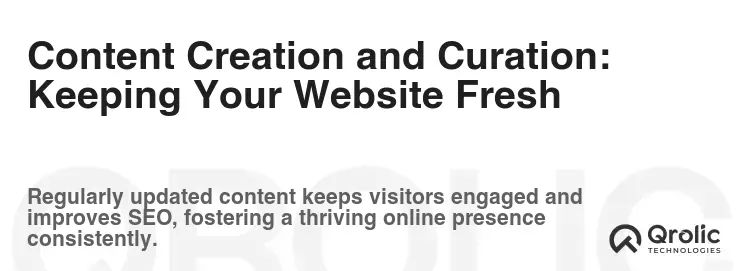
A website is never truly “finished.” Consistent content creation and curation are vital for maintaining audience engagement and attracting new readers.
Original Content Creation
Why is original content important? It sets you apart from the competition, attracts new readers, and establishes your authority in your niche.
Content Ideas:
- In-depth articles on trending topics.
- Exclusive interviews with industry experts.
- Original reporting on local news and events.
- Opinion pieces and editorials.
- Multimedia content like videos and podcasts.
Tips for Success:
- Create a content calendar to plan and organize your content creation efforts.
- Write compelling headlines that grab attention.
- Use high-quality images and videos to enhance your content.
- Promote your content on social media and other channels.
Content Curation
What is content curation? The process of finding, organizing, and sharing relevant content from other sources.
Why is it important? It provides value to your audience, saves you time, and helps you build relationships with other websites.
Tips for Success:
- Choose content that is relevant to your audience and aligns with your brand.
- Provide context and commentary when sharing content.
- Give credit to the original source.
- Use social media and email newsletters to share curated content.
Repurposing Print Content for the Web
Why repurpose print content? It saves you time and effort, maximizes the value of your existing content, and reaches a wider audience.
How to do it:
- Adapt articles from your print publication for online consumption.
- Break up long articles into shorter, more digestible pieces.
- Add multimedia elements like images, videos, and interactive graphics.
- Optimize your content for SEO.
Engaging with Your Audience
Why is audience engagement important? It builds loyalty, encourages repeat visits, and generates valuable feedback.
Ways to Engage:
- Respond to comments and questions on your website and social media channels.
- Run contests and giveaways.
- Host online events like webinars and Q&A sessions.
- Solicit feedback from your audience through surveys and polls.
- Encourage user-generated content.
Analyzing and Optimizing: Measuring Your Success
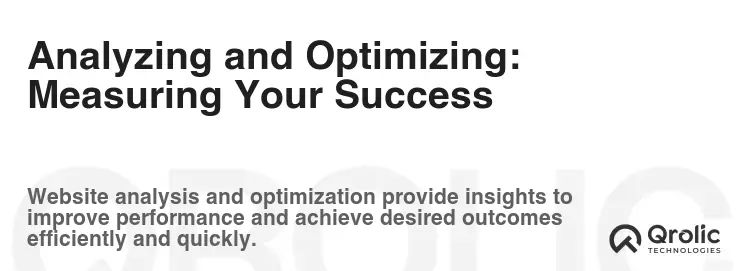
Website analytics are essential for understanding how your website is performing and identifying areas for improvement.
Setting Up Analytics Tracking
What tools to use? Google Analytics is the most popular and widely used web analytics platform.
Key Metrics to Track:
- Traffic: Number of visitors, page views, sessions, and bounce rate.
- Engagement: Time on page, pages per session, and scroll depth.
- Conversions: Subscription sign-ups, ad clicks, and e-commerce sales.
- Traffic Sources: Where your visitors are coming from (e.g., organic search, social media, referrals).
- Audience Demographics: Age, gender, location, and interests of your visitors.
Why is it important? Analytics tracking provides valuable insights into your website’s performance and user behavior.
Monitoring Key Performance Indicators (KPIs)
What are KPIs? Measurable values that demonstrate how effectively you are achieving your key business objectives.
Examples:
- Website Traffic: Number of visitors to your website.
- Subscription Rate: Percentage of visitors who subscribe to your print or digital publications.
- Ad Revenue: Revenue generated from advertising on your website.
- Bounce Rate: Percentage of visitors who leave your website after viewing only one page.
- Conversion Rate: Percentage of visitors who complete a desired action (e.g., sign up for a newsletter, make a purchase).
Why is it important? Monitoring KPIs allows you to track your progress towards your goals and identify areas where you need to improve.
A/B Testing
What is A/B testing? A method of comparing two versions of a web page or element to see which one performs better.
How to do it:
- Create two versions of a web page or element with different variations.
- Randomly show each version to a different group of users.
- Track the performance of each version using analytics.
- Implement the version that performs better.
What to test?
- Headlines
- Images
- Call-to-action buttons
- Layout
- Pricing
Why is it important? A/B testing allows you to optimize your website for conversions and improve user experience.
Making Data-Driven Decisions
Why is data important? Use your website analytics data to make informed decisions about your content strategy, design, and marketing efforts.
Examples:
- If you see that a particular article is generating a lot of traffic, create more content on that topic.
- If you see that your bounce rate is high on a particular page, optimize the page for readability and engagement.
- If you see that a particular call-to-action button is not performing well, test different variations of the button.
Qrolic Technologies: Your Partner in Digital Transformation
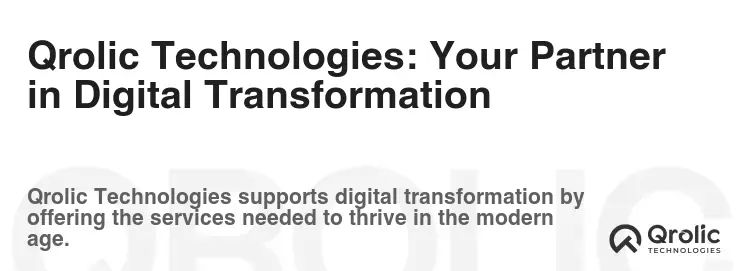
At Qrolic Technologies, we understand the unique challenges faced by print media organizations in today’s digital landscape. We offer a comprehensive suite of services to help you create a powerful online presence, engage your audience, and generate revenue.
Website Development and Design
We specialize in developing custom websites for print media organizations using platforms like WordPress, Drupal, and headless CMS solutions. Our experienced designers and developers will create a visually appealing and user-friendly website that reflects your brand identity and meets your specific needs.
SEO and Digital Marketing
Our SEO experts will help you optimize your website for search engines and drive organic traffic. We also offer a range of digital marketing services, including social media marketing, email marketing, and paid advertising, to help you reach a wider audience and promote your content.
Content Strategy and Creation
Our content strategists will work with you to develop a content strategy that aligns with your business goals and target audience. We can also help you create high-quality content that is engaging, informative, and SEO-friendly.
Consulting and Support
We offer consulting services to help you navigate the complexities of the digital landscape and develop a digital transformation strategy. Our dedicated support team is available to provide ongoing support and maintenance for your website.
Why Choose Qrolic Technologies?
- Experience: We have extensive experience working with print media organizations of all sizes.
- Expertise: Our team of experts has the skills and knowledge to help you succeed online.
- Custom Solutions: We offer custom solutions tailored to your specific needs and budget.
- Results-Driven: We are committed to delivering results and helping you achieve your business goals.
- Partnership: We work closely with our clients to build long-term partnerships.
Visit our website at https://qrolic.com/ to learn more about our services and how we can help you transform your print media business for the digital age.
Legal Considerations: Protecting Your Content and Users
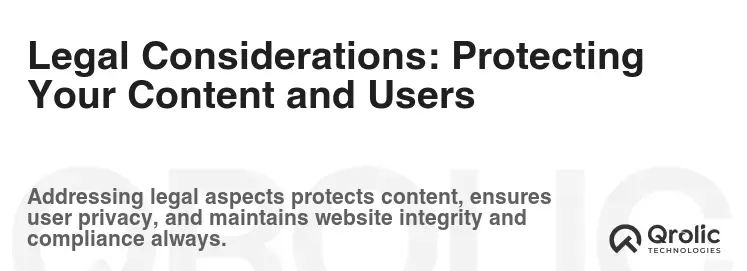
Navigating the legal landscape is crucial for any online publisher. This section highlights key legal considerations for your print media website.
Copyright Law
What is copyright? The legal right granted to the creator of original works, including literary, dramatic, musical, and certain other intellectual works.
Key Considerations:
- Original Content: Ensure that all original content published on your website is protected by copyright.
- Third-Party Content: Obtain permission before using copyrighted material from other sources.
- Fair Use: Understand the principles of fair use, which allow for limited use of copyrighted material for purposes such as criticism, commentary, news reporting, teaching, scholarship, and research.
- DMCA Compliance: Comply with the Digital Millennium Copyright Act (DMCA), which provides a safe harbor for online service providers who remove infringing content from their websites.
Privacy Policy
What is a privacy policy? A document that describes how you collect, use, and protect the personal information of your website visitors.
Key Requirements:
- Transparency: Clearly disclose what information you collect, how you use it, and with whom you share it.
- Consent: Obtain consent from users before collecting their personal information.
- Security: Implement appropriate security measures to protect personal information from unauthorized access, use, or disclosure.
- Compliance: Comply with applicable privacy laws, such as the General Data Protection Regulation (GDPR) in the European Union and the California Consumer Privacy Act (CCPA) in California.
Terms of Service
What are terms of service? A document that outlines the rules and regulations that users must agree to in order to use your website.
Key Provisions:
- Acceptable Use: Define acceptable and unacceptable uses of your website.
- User Conduct: Prohibit users from engaging in harmful or illegal activities.
- Disclaimer of Liability: Limit your liability for damages arising from the use of your website.
- Governing Law: Specify the jurisdiction that will govern the terms of service.
Advertising Standards
What are advertising standards? Guidelines that regulate the content and presentation of advertising.
Key Considerations:
- Truthfulness: Ensure that all advertising is truthful and accurate.
- Substantiation: Have evidence to support all claims made in advertising.
- Disclosure: Clearly disclose any material connections between advertisers and your publication.
- Compliance: Comply with applicable advertising laws and regulations.
Disclaimer: This information is for general guidance only and does not constitute legal advice. Consult with an attorney to ensure that your website complies with all applicable laws and regulations.






